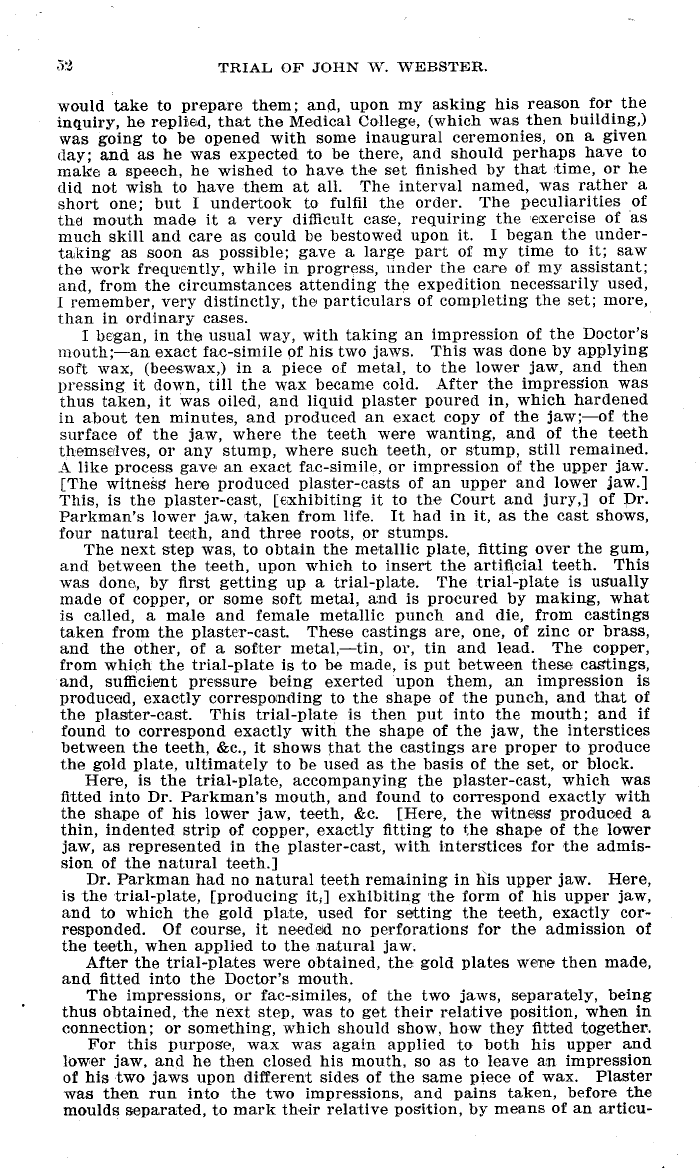|
TRIAL OF JOHN W. WEBSTER.
would take to prepare them; and, upon my asking his reason for the
inquiry, he replied, that the Medical College, (which was then building,)
was going to be opened with some inaugural ceremonies, on a given
day; and as he was expected to be there, and should perhaps have to
make a speech, he wished to have the set finished by that time, or he
(lid not wish to have them at all. The interval named, was rather a
short one; but I undertook to fulfil the order. The peculiarities of
thd mouth made it a very difficult case, requiring the exercise of as
much skill and care as could be bestowed upon it. I began the under-
taking as soon as possible; gave a large part of my time to it; saw
the work frequently, while in progress, under the care of my assistant;
and, from the circumstances attending the expedition necessarily used,
I remember, very distinctly, the, particulars of completing the set; more,
than in ordinary cases.
I began, in the usual way, with taking an impression of the Doctor's
mouth; an exact fac-simile of his two jaws. This was done by applying
soft wax, (beeswax,) in a piece of metal, to the lower jaw, and then
pressing it down, till the wax became cold. After the impression was
thus taken, it was oiled, and liquid plaster poured in, which hardened
in about ten minutes, and produced an exact copy of the jaw; of the
surface of the jaw, where the teeth were wanting, and of the teeth
themselves, or any stump, where such teeth, or stump, still remained.
A like process gave an exact fac-simile, or impression of the upper jaw.
[The witness here produced plaster-casts of an upper and lower jaw.]
This, is the plaster-cast, [exhibiting it to the Court and jury,] of Dr.
Parkman's lower jaw, taken from life. It had in it, as the cast shows,
four natural teeth, and three roots, or stumps.
The next step was, to obtain the metallic plate, fitting over the gum,
and between the teeth, upon which to insert the artificial teeth. This
was done, by first getting up a trial-plate. The trial-plate is usually
made of copper, or some soft metal, and is procured by making, what
is called, a male and female metallic punch and die, from castings
taken from the plaster-cast. These castings are, one, of zinc or brass,
and the other, of a softer metal,-tin, or, tin and lead. The copper,
from which the trial-plate is to be made, is put between these castings,
and, sufficient pressure being exerted upon them, an impression is
produced, exactly corresponding to the shape of the punch, and that of
the plaster-cast. This trial-plate is then put into the mouth; and if
found to correspond exactly with the shape of the jaw, the interstices
between the teeth, &c., it shows that the castings are proper to produce
the gold plate, ultimately to be used as the basis of the set, or block.
Here, is the trial-plate, accompanying the plaster-cast, which was
fitted into Dr. Parkman's mouth, and found to correspond exactly with
the shape of his lower jaw, teeth, &c. [Here, the witness produced a
thin, indented strip of copper, exactly fitting to the shape of the lower
jaw, as represented in the plaster-cast, with interstices for the admis-
sion of the natural teeth.]
Dr. Parkman had no natural teeth remaining in his upper jaw. Here,
is the trial-plate, [producing it;] exhibiting the form of his upper jaw,
and to which the gold plate, used for setting the teeth, exactly cor-
responded. Of course, it needed no perforations for the admission of
the teeth, when applied to the natural jaw.
After the trial-plates were obtained, the gold plates were then made,
and fitted into the Doctor's mouth.
The impressions, or fac-similes, of the two jaws, separately, being
thus obtained, the next step, was to get their relative position, when in
connection; or something, which should show, how they fitted together.
For this purpose, wax was again applied to both his upper and
lower jaw, and he then closed his mouth, so as to leave an impression
of his two jaws upon different sides of the same piece of wax. Plaster
was then run into the two impressions, and pains taken, before, the
moulds separated, to mark their relative position, by means of an articu-
|

